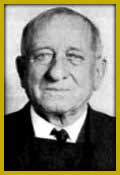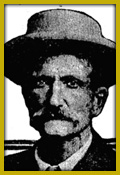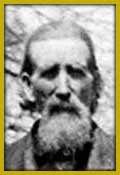

On Stage - Head Table - The Membership - Blacklist - Visitors
|
Meet the Famous Blonger Bros., Sam and Lou, sporting men of the Wild West, and lords of the Denver underworld for a quarter of a century.
Lou Blonger ("The Fixer")
A born charmer, diminutive Lou, with his older brother Sam, worked the boomtowns of the West in the 1860s and '70s running saloons, gambling houses, theaters and brothels. They both became well-known across the western region as professional gamblers. With time, the Blonger Bros. found their talents and demeanor also well-suited to occasional "official" work as lawmen or detectives, a sideline often undertaken by sporting men with the requisite grit — and a useful one to those involved in bunco schemes, also a common pasttime among gamblers. The ties they forged in this line of work would appreciate in value as their friends rose to positions of power in city, state, even federal posts. By the turn of the century the brothers had such influence in Denver that bunco gangs did not operate there unless under the Blonger's control, and not without paying a hefty percentage to the brothers for every score. In its prime, the operation raked in as much as a half million dollars a year using so-called big store cons such as the rag and the wire. Lou's influence at city hall, police headquarters, the sheriff's department, and even the Denver Post and U.S. Marshal's office, kept him out of jail and out of the spotlight, on most occasions. His control of the Denver bunco trade lasted over twenty-five years, and in that time none of his gang served hard time — until 1922 when Lou, at age 74, was finally out-maneuvered by Denver DA Col. Philip Van Cise and sentenced to the penitentiary at Cañon City. "They framed me," he said. "I'm an old man and I never hurt anybody, but they framed me." More about Lou BlongerMarshal Sam BlongerLou's older brother Sam was a big man, taciturn, with steady nerves, who wore blue glasses to hide the eye disfigured in a Denver shootout. An experienced lawman and detective, Sam was by all reports a fearless individual, a hard case in general, and known to confide only in his loyal brother Lou. Sam is today most remembered as one of Albuquerque's earliest town marshals. Lou was his deputy. "Marshal Blonger's conduct Saturday night proved that he is a brave man and no wanton killer. Had he shot Jones, he would have been promptly acquitted." A renowned professional gambler like Lou, Sam owned several racehorses, and was a successful mining speculator as well. Sam had many friends in high places by the 1890s — many Knights of the Green Cloth found themselves in the halls of power as the years went by — and he used that influence to help wrest control of the Denver bunco machine from "Big Ed" Chase, and Soapy Smith, who ultimately fled Denver for the Klondike. Sam died in 1914, leaving Lou to ultimately take the fall. More about Sam BlongerJoe Blonger
Shot in the chest during the Union's siege of Atlanta, brother Joe later took up a solitary life of prospecting in the Black Hills, and later New Mexico, Arizona and California. Said by his own account to have been a friend to Sitting Bull and Crazy Horse, and a poker pal of Wild Bill, he may also have been acquainted with George Custer, Buffalo Bill, Deadwood's Bill Nuttall, and others. Joe claimed to have been at the Little Big Horn the day after Custer's demise, where he learned the truth of the battle from his young Indian friends. "I've lived in the toughest towns in the West — Abilene, Dodge City, and all the rest, and I kept out of trouble by minding my own business and staying sober. That's my advice to all young men — mind your own business and don't get drunk." In 1897 Joe shot and killed his boss, Alexander Allan, to save the life of Silas Smith. "Allan picked up a rock and as he held it over Smith's head said: 'I'll brain you right here.' I don't know how it happened, but I fired at Allan and the bullet struck him either in the chin or just below. Allan sprang up and ran in circles, falling as he ran. In less than five minutes after I shot him he was dead. Before he died, I went to him and told him I was sorry, very sorry that the shooting had happened. He tried to answer me, but his breathing was so difficult and the blood was rushing from the wound so rapidly that I could not understand what he said." You don't see Joe much, but he stops by when he's in town. Never drinks — unless you're buying. Always good for a tall tale or two. More about Joe BlongerMike Belonger
Mike never went West with his brothers. He also never shared in his brothers' wealth, apparently, so don't expect to see him. But he's always welcome. The first of the Belonger boys to enlist, Mike served at Second Bull Run, the Battle of Winchester, Cedar Mountain, and finally the cornfield at Antietam, after which he succumbed to an ailment of the heart, and was discharged. Back home in Shullsburg, Wisconsin, the infirm Michael took a small plot of land that he farmed for the rest of his life. Despite his weakened condition, Mike sired ten children, and has a great many living descendants. Mike was renowned as a musician, and his fiddle-playing was said to have been admired by the likes of Ole Bull and Ulysses S. Grant. More about Mike BelongerSimon BlongerThe eldest of the Blonger Bros., Simon appears to have been in the mining industry all his life. For a time he was superintendent of the Robert E. Lee in Leadville, and worked for Sam and Lou at their Forest Queen mine in Cripple Creek. He served as a Colorado assemblyman for one term. Around 1902, Simon found himself involved in a get-rich-quick scheme with big repercussions. A sizeable coal field had been located in Alaska, and Standard Oil wanted the coal. It was perfect for shipping to the West Coast — perfect for supplying the growing Pacific fleet. But federal law prohibited incorporating such lands into large claims, thanks in large part to the conservationist sympathies of President Teddy Roosevelt. What to do? A group of influential Seattle businessmen, apparently including Simon, were signed on to make the claims individually, after which they would all sell out to Standard at a handsome profit. Unfortunately, the deal was discovered, and the claims went into limbo for several years. In 1908, Taft took office, and his Secretary of the Interior, Richard Ballinger, was soon embroiled in a controversy surrounding the settlement of the coal claims and his possible interest in and influence over the outcome of the case. The scandal has been called the Ballinger-Pinchot affair, and it is said that Roosevelt was so incensed by the actions of Taft and his cronies that Roosevelt ran against him in the next election, splitting the Republican vote and paving the way for the Wilson presidency. We are told the coalfield later proved less than massive. More about Simon BlongerMarvin BlongerThe youngest Blonger, Marvin was a miner his entire life. We believe he worked with Sam and Lou's mining company in Denver, then later on their claims in Montana.
Cora Blonger ("Nola")In 1889, Lou Blonger married Nola Lyons, age 30; Lou was 40. It was his second marriage, her third. In her young adulthood Nola was a "successful variety actress, who was a high-class woman," according to Fighting the Underworld. If she really was a performer, it may be possible to find out more about her career before she met Lou. It's also possible that her "performances" were more of the type found in the saloons and dance halls owned and operated by Lou Blonger and his ilk. Lou was notoriously unfaithful to Nola. But when his death behind prison walls became inevitable, the couple reconciled and Lou transferred the remains of his fortune to Nola's name. Three months after Lou died, Nola married William McCauley. The couple lived in comfort at the Cosmopolitan Hotel until her passing in 1936. If she shows up, push the green buzzer. More about Nola BlongerIola Readon ("Berna Rames")Lou Blonger had been separated from his wife for many years at the time of his arrest in 1922. Well, not exactly. He and Nola lived together on weekends, while on weekdays Lou shacked up on Williams Street with his mistress, who Van Cise called "Berna Rames". Her real name, Iola Readon, was revealed in the Denver Post shortly after the trial in a divorce suit filed by her step-father against her mother. Post sob sister Frances Wayne penned a maudlin interview with Nola, who had known about the arrangement for twenty years. According to both this interview and Van Cise, Lou had met Iola at an early age, perhaps as young as 15. By the time of the arrests she was 36 years old. [Suter] charges further, in his complaint, that the alleged relations between Blonger and his wife's daughter began when the latter was 15 or 16 years of age and that when he [Mr. Suter] remonstrated with Mrs. Suter over the alleged conduct of her daughter she flew into a fit of temper and insinuated he should get into the bunco game. It is not known what became of Iola Readon after Lou Blonger was sent to prison and died. The 1930 census lists Iola Reardon [sic] at 1475 Humboldt, a couple of a blocks away from the mansion Blonger built for her. More about Iola ReadonKate Blonger ("Kitty")In 1888, hooker Kitty was tried for murder, and acquitted, in Kingman, Arizona. When Charles Hill burst into her room in the back of a Peach Springs saloon, he found her with a young gambler called Kid Fay. A scuffle ensued, and Kitty shot Hill in the head. "'My God, what have you done?' she replied, 'I don't know, I have killed him.'" Evidence indicates Kitty was part of the Blonger stable during their year in Albuquerque, and, indeed, Lou rode to her rescue when she went on trial. But Lou, apparently, was not her primary connection. Though Kitty pledged to go back East after the trial, the next year she married Sam some twenty days after his divorce from Ella Livingston. At that time Kate was divorced and going by the name Sadie Wilson. In 1893 Sam and Sadie divorced on grounds of extreme cruelty. Sadie and others vividly described how Sam brutally attacked his wife on several occasions. More about Kitty BlongerMollie BlongerHere's all we know about Mollie, from Albuquerque in 1888, three days after Kitty Blonger's acquital: "Territory vs. Mollie Blonger; maintaining a nuisance; pluries writ ordered, and scire facias." Sam and Lou were long gone from that town by 1888. So who was Mollie? Another girl from Lou's stable, circa 1882? The madam known in Albuquerque as "Blonger's woman?" |
